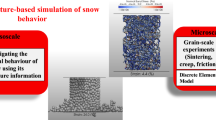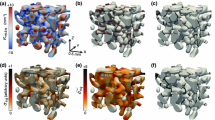Abstract
A framework for investigating the mechanics of snow is proposed based on an advanced micro-scale approach. Varying strain rates, densities and temperatures are taken into account. Natural hazards i.e. snow avalanches are triggered by snow deforming at low rates, while a large group of industrial applications concerning driving safety or winter sport activities require an understanding of snow behaviour under high deformation rates. On the micro-scale, snow is considered to consist of ice grains joined by ice bonds to build a porous structure. Deformation and failure of bonds and the inter-granular collisions of ice grains determine the macroscopic response under mechanical load. Therefore, this study proposes an inter-granular bond and collision model for snow based on the discrete element method to describe interaction on a grain-scale. It aims at predicting the mechanical behaviour of ice particles under different strain rates using a unified approach. Thus, the proposed algorithm predicts the displacement of each individual grains due to inter-granular forces and torques that derive from bond deformation and grain collision. For this purpose, the inter-granular characteristics are approximated by an elastic viscous-plastic material law which is based on the temperature-dependent properties of poly-crystalline ice Ih.
Graphic abstract














Similar content being viewed by others
References
Akkok, M., Ettles, C.M.M., Calabrese, S.J.: Parameters affecting the kinetic friction of ice. J. Tribol. 109, 552–559 (1987). https://asmedigitalcollection.asme.org/tribology/article-pdf/109/3/552/5696634/552_1.pdf
Allen, M., Allen, M., Tildesley, D., Allen, T., Tildesley, D.: Computer simulation of liquids. Clarendon Press, Oxford Science Publ, Oxford (1989)
Barnes, P., Tabor, D., Walker, J.C.F., And, F.R.S.: The friction and creep of polycrystalline ice. Proc. R. Soc. Lond. Ser. A Math. Phys. Sci. 1557, 127–155 (1971)
Bazant, Z., Zi, G., Mcclung, D.: Size effect law and fracture mechanics of the triggering of dry snow slab avalanches. J. Geophys. Res. (Solid Earth) (2003). https://doi.org/10.1029/2002JB001884
Brendel, L., Pengiran, Y., Röck, M., Wahl, M., Bröckel, U.: Modeling of caked contacts in dems. Chem. Eng. Technol. 29, 1355–1359 (2006). https://doi.org/10.1002/ceat.200600132
Colbeck, S.C.: A review of sintering in seasonal snow. CRREL Rep. 97–10 (1997)
Cundall, P.A., Strack, O.D.L.: A discrete numerical model for granular assemblies. Géotechnique 29, 47–65 (1979)
Džiugys, A., Peters, B.: An approach to simulate the motion of spherical and non-spherical fuel particles in combustion chambers. Granul. Matter 3, 231–266 (2001)
Džiugys, A., Peters, B., Hunsinger, H., Krebs, L.: Evaluation of the residence time of a moving fuel bed on a forward acting grate. Granul. Matter 8, 125–135 (2006)
Džiugys, A., Peters, B., Navakas, R., Misiulis, E.: Density segregation on a moving grate. Powder Technol. 305, 323–332 (2017)
Fan, X., Ten, P., Clarke, C., Bramley, A., Zhang, Z.: Direct measurement of the adhesive force between ice particles by micromanipulation. Powder Technol. 131, 105–110 (2003)
Faraday, M.: Note on regelation. Proc. R. Soc. Lond. 10, 440–450 (1859)
Gammon, P.H., Kiefte, H., Clouter, M.J., Denner, W.W.: Elastic constants of artificial and natural ice samples by brillouin spectroscopy. J. Glaciol. 29, 433–460 (1983)
Gaume, J., Van Herwijnen, A., Chambon, G., Birkeland, K.W., Schweizer, J.: Modeling of crack propagation in weak snowpack layers using the discrete element method. Cryosphere 9, 1915–1932 (2015)
Gubler, H.: Strength of bonds between ice grains after short contact times. J. Glaciol. 28, 457–473 (1982)
Hagenmuller, P., Chambon, G., Flin, F., Morin, S., Naaim, M.: Snow as a granular material: Assessment of a new grain segmentation algorithm. Granular Matter 16, 421–432 (2014)
Hagenmuller, P., Chambon, G., Lesaffre, B., Flin, F., Naaim, M.: Energy-based binary segmentation of snow microtomographic images. J. Glaciol. 59, 859–873 (2013)
Hagenmuller, P., Chambon, G., Naaim, M.: Microstructure-based modeling of snow mechanics: a discrete element approach. Cryosphere 9, 1969–1982 (2015)
Hertz, H.: Über die Berührung fester elastischer Körper. J. R. Angew. Math. 92, 156–171 (1881)
Higa, M., Arakawa, M., Maeno, N.: Size dependence of restitution coefficients of ice in relation to collision strength. Icarus 133, 310–320 (1998)
Johnson, J.B., Hopkins, M.A.: Identifying microstructural deformation mechanisms in snow using discrete-element modeling. J. Glaciol. 51, 432–442 (2005)
Kabore, B., Peters, B., Willibald, C., Thiele, T., Schneebeli, M.: Multi-scale modelling of snow mechanics. In: 41st Solid Mechanics Conference (SOLMECH 2018), Warsaw, Poland (2018)
Kabore, B.W., Peters, B.: Micromechanical model for sintering and damage in viscoelastic porous ice and snow. Part I: Model and calibration. Int. J. Solids Struct. 185–186, 324–333 (2020a)
Kabore, B.W., Peters, B.: Micromechanical model for sintering and damage in viscoelastic porous ice and snow. Part ii: Validation. Int. J. Solids Struct. 185–186, 281–291 (2020b)
Kaempfer, T.U., Schneebeli, M.: Observation of isothermal metamorphism of new snow and interpretation as a sintering process. J. Geophys. Res. Atmos. https://agupubs.onlinelibrary.wiley.com/doi/pdf/10.1029/2007JD009047 (2007)
Kim, S.Y., Sasaki, Y.: Simulation of effect of pore structure on coke strength using 3-dimensional discrete element method. ISIJ Int. 50, 813–821 (2010)
Kinosita, S.: Compression of snow at constant speed. In: International conference on low temperature science: physics of snow and ice, pp. 911–927 (1967)
Kirchner, H.O.K., Michot, G., Narita, H., Suzuki, T.: Snow as a foam of ice: plasticity, fracture and the brittle-to-ductile transition. Philos. Mag. Part A 81, 2161–2181 (2001)
Lin, X., Ng, T.T.: A three-dimensional discrete element model using arrays of ellipsoids. Géotechnique 47, 319–329 (1997). https://doi.org/10.1680/geot.1997.47.2.319
Mark, M., 2014. Discrete approach to describe the kinematics between snow and a tire tread. Ph.D. thesis. University of Luxembourg
Mellor, M.: A review of basic snow mechanics. In: Snow mechanics Symposium, pp. 251–291. IAHS-Publication, Grindelwald (1974)
Meyssonnier, J., Philip, A., Capolo, L., Mansuy, P.: Experimental studies of the viscoplasticty of ice and snow. In: Kolymbas, D. (ed.) Mechanics of Natural Solids, pp. 203–221. Springer, Berlin Heidelberg (2009)
Nakaya, U., Matsumoto, A.: Simple experiment showing the existence of “liquid water-film” on the ice surface. J. Colloid Sci. 9, 41–49 (1954)
Nicot, F.: Constitutive modelling of a snow cover with a change in scale. Eur. J. Mech. A/Solids 22, 325–340 (2003a)
Nicot, F.: (trad auto) Multiscale modelling of geomaterials. Contribution to the treatment of natural risks. Habilitation à diriger des recherches. Habilitation à diriger des recherches,INPG Grenoble (2003b)
Nicot, F.: Constitutive modelling of snow as a cohesive-granular material. Granul. Matter 6, 47–60 (2004a)
Nicot, F.: From constitutive modelling of a snow cover to the design of flexible protective structures part i—mechanical modelling. Int. J. Solids Struct. 41, 3317–3337 (2004b)
Nicot, F.: From constitutive modelling of a snow cover to the design of flexible protective structures part ii—some numerical aspects. Int. J. Solids Struct. 41, 3339–3352 (2004c)
Peinke, I., Hagenmuller, P., Chambon, G., Roulle, J.: Investigation of snow sintering at microstructural scale from micro-penetration tests. Cold Reg. Sci. Technol. 162, 43–55 (2019)
Peters, B., Besseron, X., Estupinan Donoso, A.A., Hoffmann, F., Michael, M., Mahmoudi, A.H.: Application of the extended discrete element method (XDEM) in computer-aided process engineering. CAPE Forum , 12 (2013)
Peters, B., Džiugys, A., Hunsinger, H., Krebs, L.: An approach to qualify the intensity of mixing on a forward acting grate. Chem. Eng. Sci. 60, 1649–1659 (2005)
Peters, B.: Extended discrete element method–wikipedia, the free encyclopedia. (2020). Accessed 19 May 2020 (online)
Petrenko, V., Whitworth, R.: Physics of ice. OUP, Oxford (1999)
Samiei, K., Peters, B., Bolten, M., Frommer, A.: Assessment of the potentials of implicit integration method in discrete element modelling of granular matter. Comput. Chem. Eng. 49, 183–193 (2013)
Schulson, E.M.: The brittle compressive fracture of ice. Acta Metall. Mater. 38, 1963–1976 (1990)
Schulson, E.M.: Brittle failure of ice. Eng. Fract. Mech. 68, 1839–1887 (2001)
Shaw, M., Sata, T.: The plastic behavior of cellular materials. Int. J. Mech. Sci. 8, 469–478 (1966)
Sigrist, C.: Measurement of fracture mechanical properties of snow and application to dry snow slab avalanche release (2006)
Steinkogler, W., Gaume, J., Löwe, H., Sovilla, B., Lehning, M.: Granulation of snow: from tumbler experiments to discrete element simulations. J. Geophys. Res. Earth Surf. 120, 1107–1126 (2015). https://doi.org/10.1002/2014JF003294
Szabo, D., Schneebeli, M.: Subsecond sintering of ice. Appl. Phys. Lett. 90, 151916 (2007)
Tsuji, Y., Tanaka, T., Ishida, T.: Lagrangian numerical simulation of plug flow of cohesionless particles in a horizontal pipe. Powder Technol. 71, 239–250 (1992)
Varrette, S., Bouvry, P., Cartiaux, H., Georgatos, F.: Management of an academic HPC cluster: the UL experience. In: 2014 international conference on high performance computing simulation (HPCS), pp. 959–967 (2014)
Voitkovsky, K., Bozhinsky, A., Golubev, V., Laptev, M., Zhigulsky, A., Slesarenko, Y.: Creep-induced changes in structure and density of snow. 1974 Snow Mechanics Symposium, pp. 171–179. IAHS Publ, Grindelwald (1975)
Walton, O., Braun, R.L.: Viscosity, granular-temperature, and stress calculations for shearing assemblies of inelastic, frictional disks. J. Rheol. 30, 949–980 (1986)
Yong, R.N., Metaxas, I.: Influence of age-hardening and strain-rate on confined compression and shear behaviour of snow. J. Terramech. 22, 37–49 (1985)
Acknowledgements
The presented research project is financed by the National Research Fund of Luxembourg (FNR). Simulations presented in this study were carried out on the High-Performance-Computing facility (HPC) of the University of Luxembourg, see [52].
Author information
Authors and Affiliations
Corresponding author
Ethics declarations
Conflict of interest
None.
Additional information
Publisher's Note
Springer Nature remains neutral with regard to jurisdictional claims in published maps and institutional affiliations.
Rights and permissions
About this article
Cite this article
Kabore, B.W., Peters, B., Michael, M. et al. A discrete element framework for modeling the mechanical behaviour of snow—Part I: Mechanical behaviour and numerical model. Granular Matter 23, 42 (2021). https://doi.org/10.1007/s10035-020-01083-1
Received:
Accepted:
Published:
DOI: https://doi.org/10.1007/s10035-020-01083-1




